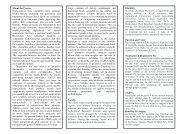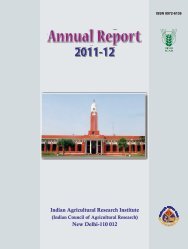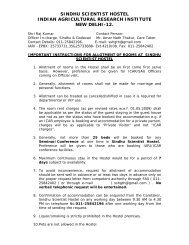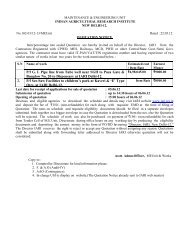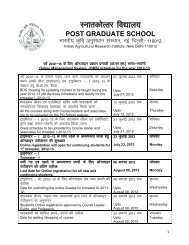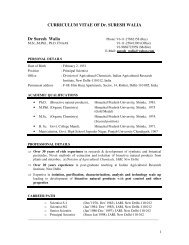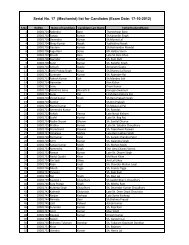May - Aug - Indian Agricultural Research Institute
May - Aug - Indian Agricultural Research Institute
May - Aug - Indian Agricultural Research Institute
Create successful ePaper yourself
Turn your PDF publications into a flip-book with our unique Google optimized e-Paper software.
Nilgiri Wheat News<br />
(<strong>May</strong> – <strong>Aug</strong>ust, 2012)<br />
IARI, Regional Station, Wellington<br />
Vol 4 (2)<br />
HW 1098 (Pusa Nilgiri) - India's first<br />
mutant semi dwarf dicoccum wheat<br />
for Gujarat, Maharashtra, Karnataka<br />
and Tamil Nadu<br />
M. Sivasamy 1 , Jagdish Kumar 1 , P. Jayaprakash 1 , V.K.Vikas 1 ,<br />
Rebekah Nisha 1 , John Peter 1 , Vinod 2 , Sanjay Kumar 2 , G.P.<br />
Singh 2 ,.R.K. Sharma 2 , Rajbir Yadav 2 ,Vinod Prabhu2,<br />
S.C.Mishra 3 , S. A. Desai 4 , Kalappanavar 4 ,.B.N Patil 4 ,<br />
R.R.Hanchinal 4 , S. Bojan 1 , K. Sivan 1 and R.Suresh 1<br />
1 IARI, Regional Station, Wellington, 2 Division of Genetics,<br />
IARI, New Delhi, 3 ARI, MACS, Pune, 4 UAS, Dharward<br />
India's first mutant semi-dwarf dicoccum<br />
HW 1098 developed at IARI, Regional<br />
Station, Wellington employing gamma<br />
irradiation was identified for release<br />
during the 51 st AICW&BIP scientists'<br />
meet held at Durgapura, Jaipur on 24-27,<br />
<strong>Aug</strong>ust, 2012. The area under dicoccum<br />
wheat is increasing steadily because of<br />
its increased demand in the recent past<br />
as health food. Varieties viz., NP200,<br />
NP201 and NP 202 released during<br />
1960's were widely cultivated for its<br />
1<br />
nutritional quality. The semi dwarf<br />
varieties released in recent times so far<br />
has the high yielding potential but they<br />
have invariably used the dwarfing genes<br />
derived from durum which in-turn alters<br />
its dicoccum quality maintained by the<br />
varieties like NP 200, NP201 etc., to<br />
certain extent. And this attributed to a<br />
strong linkage drag associated with<br />
dwarfing genes from durum. The variety<br />
HW 1098 is a direct mutant of NP 201<br />
employing gamma irradiation technique<br />
which has the ideal plant height,<br />
resistant to rust diseases, with high<br />
HW 1098 ( Pusa Nilgiri) - a dicoccum<br />
wheat variety for health food<br />
yielding ability combined with better
quality as comparable to parent NP 201.<br />
With the current market price ruling<br />
high for dicoccums due to their<br />
therapheutical value, cultivation of HW<br />
1098 is likely to be more remunerative<br />
to the resource poor farmers.<br />
HW 5216 (Pusa Thenmalai) - a bread<br />
wheat variety with diverse gene<br />
sources to combat rust diseases at foci<br />
areas (Southern Hill Zone) identified<br />
for release<br />
M. Sivasamy 1 , Jagdish Kumar 1 , P. Jayaprakash, V.K.Vikas 1 ,<br />
Rebekah Nisha 1 , John Peter 1 Vinod 2 , Sanjay Kumar 2 , G.P.<br />
Singh 2 , R.K. Sharma 2 , Rajbir Yadav 2 , J.B.Sharma and<br />
Vinod Prabhu 2 , S. Bojan 1 , . K. Sivan 1 , Satya Prakash 1 and<br />
R.Suresh 1<br />
1 IARI, Regional Station, Wellington, 2 Division of Genetics,<br />
IARI, New Delhi<br />
In the 51 st AICW&BIP wheat workshop<br />
yet another high yielding, multiple<br />
disease resistant wheat variety developed<br />
at IARI, Regional Station, wellington<br />
got identified for release for Southern<br />
hill zone which carries diverse gene<br />
sources conferring multiple disease<br />
resistance. The areas suitable for<br />
cultivation of this variety include<br />
Southern hills viz., The Nilgiri, Palnani,<br />
Kodaikanal, Thalawadi, Yercaud,<br />
Servaranya, Koll hills, Javadu and<br />
M.M.hills. Areas adjoining these hills<br />
include Theni, Dindigul, Coimbatore,<br />
Erode, Salem, Thirupur, Namakkal,<br />
Dharmapuri, Krishnagiri, Vellore,<br />
Thruvannamalai and Vilupuram districts<br />
in Tamil Nadu and Chamrajnagar,<br />
Mysore, Kodagu, Bengaluru rural, Kolar<br />
and Hassan districts in Karnataka. The<br />
Southern hills are known as the main<br />
foci for leaf and stem rust and acts as<br />
source for fresh epidemics of rusts to the<br />
plains of India where wheat is cultivated<br />
in winter. Although Southern hill is<br />
small zone in area wise but strategically<br />
very important zone for India,<br />
particularly for controlling the rust.<br />
2<br />
Therefore, containing the rust inoculum<br />
through continuous effort by<br />
diversifying genetic basis of rust<br />
resistance and releasing in the Southern<br />
hills is very important. Hence<br />
development of high yielding, rust<br />
resistant wheat varieties and their release<br />
and saturation in these areas is of<br />
national importance in order to arrest the<br />
dissemination of uredospores to the<br />
plains of the country.<br />
The agro-ecological conditions<br />
prevailing in the SHZ allows wheat to be<br />
grown throughout the year as relay crop<br />
and all stages of crop growth are present<br />
at any point of time in a year.<br />
Cultivation of susceptible wheat variety<br />
to rust diseases acts as a green bridge<br />
through which disease multiply and<br />
survive throughout the year. Therefore<br />
release of wheat variety with high degree<br />
rust resistance will help in containing the<br />
rust inoculum in Sothern hill zone. The<br />
variety HW 5216 confers high degree of<br />
rust resistance to black and brown rust<br />
both under natural and artificial<br />
epiphytotic conditions. Also the variety<br />
HW 5216 gives adult plant field<br />
resistance to<br />
yellow rust and<br />
powdery mildew<br />
as well.<br />
Since the<br />
proposed variety<br />
HW 5216 carries<br />
HW HW 5216 5216 - A A hhigh<br />
h high<br />
igh yielding yielding and<br />
and<br />
rust rust resistant resistant bread wheat variety<br />
for for for SHZ<br />
SHZ<br />
diverse and<br />
pyramided gene<br />
complex, it is<br />
expected to give durable resistance<br />
which is evident from the adult plant<br />
response to stem and leaf rust over four<br />
years of testing. The proposed variety is<br />
postulated to carry<br />
Sr31+Lr26+Yr9+Pm8. Lr 26 alone is<br />
not effective in India for leaf rust<br />
resistance. Therefore in addition to
Sr31+ complex, HW 5216 is expected<br />
to carry other genes particularly for leaf<br />
rust and it could be attributed to<br />
Thinopyrum ponticum - derived gene<br />
complex Lr24+Sr24, since one of the<br />
parent (HW 3083) carries this gene<br />
complex. In Southern hill areas and<br />
areas adjoining hills farmers are now<br />
looking for an alternate, viable, less<br />
water requiring grain crop which can<br />
produce them both grain and fodder.<br />
Better awareness to take balanced diet<br />
with rich nutritional quality the demand<br />
for wheat is increasing steadily in<br />
Southern states which is evident from<br />
the demand for breeder seed of released<br />
wheat varieties in this region in the<br />
recent past.<br />
Hybrid necrosis in wheat (Triticum<br />
aestivum L.) -" Evolutionary<br />
significance or a potential barrier for<br />
gene flow"<br />
V.K. Vikas, M. Sivasamy, Jagdish Kumar, P.Jayaprakash, P.<br />
Nallthambi and C.Uma Maheshwari<br />
Inter and<br />
intra<br />
specific<br />
crosses<br />
in wheat<br />
often<br />
produce<br />
different<br />
Necrotic plants (2 rows in centre)<br />
along with normal plants on the sides<br />
kinds of hybrid weakness such as hybrid<br />
necrosis, hybrid chlorosis and hybrid<br />
dwarfness, among which hybrid necrosis<br />
is more frequently met with. Hybrid<br />
necrosis in wheat is the pre mature<br />
gradual death of leaves and leaf sheath<br />
caused by two complementary genes Ne1<br />
and Ne2, located on chromosome arm of<br />
5BL and 2BS respectively when brought<br />
together in a hybrid combination. One<br />
hundred and five bread wheat varieties<br />
(T. aestivum L.) released by the Central<br />
Varietal Release Committee (CVRC) for<br />
3<br />
different wheat growing zones of India<br />
were studied for the frequency and<br />
distribution of necrotic genes present in<br />
them. These varieties were crossed to<br />
two T.aestivum L. testers namely, C306<br />
(Ne1Ne1ne2ne2) and HD 2329 (ne1ne1<br />
Ne2Ne2) to determine their necrotic<br />
genes. Sixty five varieties (62%) showed<br />
the presence of Ne2 gene and only nine<br />
varieties (8.5%) had Ne1 gene in their<br />
background. Thirty one varieties<br />
(29.5%) were non carrier for both<br />
necrotic genes.<br />
Most of the Ne1 carriers are of<br />
<strong>Indian</strong> origin and their pedigree revealed<br />
the involvement of old land races or<br />
varieties as parents. Moreover most of<br />
the indigenous varieties (pre green<br />
revolution period) carry Ne1 gene and<br />
India is originally a Ne1 region. Later the<br />
predominance of Ne2 gene in <strong>Indian</strong><br />
varieties of T. aestivum happened after<br />
the introduction of semi dwarf Mexican<br />
varieties due to direct selection from<br />
CIMMYT germplasm and other exotic<br />
germplasm which are mostly Ne2 carriers<br />
and also the extensive use of these<br />
germplasms in the hybridization<br />
programme with indigenous varieties.<br />
Thus the necrotic gene, Ne1 was<br />
gradually replaced with Ne2 in the<br />
modern bread wheat varieties.<br />
To know further about hybrid<br />
necrosis i.e. Why hybrid necrosis occurs<br />
in wheat species? and Why there is<br />
predominance of necrotic gene Ne2 in<br />
the modern <strong>Indian</strong> cultivars? During the<br />
course of evolution, species maintained<br />
isolation from other species to maintain<br />
their uniqueness/purity/identity and to<br />
avoid mix up with other species i.e.<br />
speciation. One of the above isolation<br />
mechanisms was maintenance of<br />
different ploidy level between species as<br />
observed in wheat species which acted<br />
as a barrier for free gene flow. Other
mechanisms like pre zygotic and post<br />
zygotic barrier also play a vital role in<br />
the speciation process. Hybrid necrosis<br />
phenomenon is one among the post<br />
zygotic barrier speciation process which<br />
act as a barrier for either inter or intra<br />
specific gene flow. During the process of<br />
breeding by human being for biotic and<br />
abiotic stresses, many useful genes were<br />
transferred from species at different<br />
ploidy level to the target species. So<br />
some of these useful genes get<br />
transferred along with the necrotic genes<br />
(linkage drag). Later high incidence of<br />
necrosis allele in breeding lines was<br />
observed due to the selection for linked<br />
beneficial traits mainly rust resistance<br />
genes. In short, hybrid necrosis is a<br />
evolutionary significant mechanism to<br />
maintain its species purity.<br />
In wheat, few genes that confer<br />
resistance to rust diseases are located in<br />
the same chromosomal arm where<br />
Ne2(2BS) gene is present viz.,<br />
Lr13,Lr16+Sr23, Lr23, Sr19,Sr36, Sr40,<br />
Yr31, Yr32 etc. Among these, leaf rust<br />
resistance genes Lr13 and Lr23 had<br />
been used extensively in the wheat<br />
breeding programme and currently stem<br />
rust resistance Sr36 is being used in the<br />
breeding programme. These correlations<br />
suggest that selection pressure exerted<br />
by the pathogen or breeding for disease<br />
resistance might directly or indirectly<br />
contribute to the predominance of Ne2<br />
gene which lead to the evolution of<br />
deleterious epistatic interactions that<br />
could give rise to gene flow barrier in<br />
wheat. Thus the occurrence of hybrid<br />
necrosis is of great concern to wheat<br />
breeders as it often interferes in the<br />
choice of elite parents from different<br />
geographical regions and thus imposes<br />
restrictions on the productivity of<br />
crosses. So, a evolutionary significance<br />
phenomenon for speciation when<br />
4<br />
utilized by human being for their<br />
advantage becomes a potential barrier<br />
for gene flow.<br />
Wheat rust surveys in Nilgiris<br />
Jagdish Kumar, P. Nallthambi, C.Umamaheshwari, M.<br />
Sivasamy, P. Jayaprakash, V.K. Vikas, John Peter and R.<br />
Nisha<br />
Three pathotypes viz. 77-5, 77-7 and 77-8 of<br />
brown rust (Puccinia triticina) and two<br />
pathotypes viz. 40A and 40-1 of black rust<br />
(P.graminis tritici) of wheat prevailed in<br />
Nilgiri hills. Pathotype 77-5 and 77-8<br />
prevailed in almost equal proportions<br />
followed by race 77-7 in brown rust. Races<br />
40A and 40-1 in black rust dominated the<br />
field flora. Ug 99 and its variants could not<br />
be observed in the Ug99 trap nursery.<br />
Pathotype 78S84 of yellow rust (P.<br />
striiformis) also existed in Nilgiris.<br />
Occurrence of wheat rusts on<br />
Barberry grove in Nilgiris Hills<br />
P. Nallathambi, Jagdish Kumar, C. Uma Maheshwari,<br />
Sandeep Kumar, John Peter and K. Jayakumar<br />
Berberis leaves with aecia (left) and enlarged view<br />
of an aecial cup on lower surface of barberis leaf<br />
(right)<br />
Systematic surveys were conducted in<br />
Thottapetta, Arakadu, Mynala,<br />
Kenthorai, Thummanahatty and<br />
Upathali area of Nilgiri hills in Tamil<br />
Nadu during June and July, 2012.<br />
Different species of Barberry were<br />
observed with rust pustules. A total of 22<br />
random samples of leaves infected with<br />
rusts have been collected from the<br />
interior area of forests in these locations.<br />
Rust pustules containing aeciospores<br />
were cross inoculated on one week old<br />
seedlings of various species of wheat
including Triticum monococcum,<br />
Triticum dicoccum, Trticum aestivum<br />
and rye (Secale cereale). The<br />
pathogenesis studies under glass house<br />
conditions indicated the infective nature<br />
of only five isolates on Triticum<br />
dicoccum and Trticum aestivum. Both<br />
brown and black rust pathogens<br />
(uredinospores) were observed under<br />
microscope and purified further using<br />
susceptible lines of wheat (var. Agra<br />
local). This is the first report from the<br />
IARI, RS, Wellington to establish wheat<br />
rusts from natural barberry grove<br />
adapted in Nilgiri hills. Further research<br />
to establish Koch’s postulates on<br />
barberry as well as wheat species are<br />
under progress.<br />
Standardization of seed germination<br />
and seedling establishment of<br />
Barberry spp. from Nilgiri Hills<br />
P. Nallathambi, Jagdish Kumar, C. Uma Maheshwari, M.<br />
Sivasamy, P. Jayaprakash, V.K. Vikas and K. Jayakumar<br />
Barberry seedlings grown in paper<br />
cups<br />
Barberry (Barberry spp.) is a long-lived<br />
woody perennial in Nilgiri hills of Tamil<br />
Nadu in India. It acts as alternate host<br />
for the wheat rust pathogens (stem and<br />
stripe rust in USA) in the absence of<br />
wheat. In order to understand the<br />
complete life cycle of the pathogen, it is<br />
imperative to know the biology of the<br />
rust pathogen in alternate host. Since the<br />
information on sequential survival of<br />
5<br />
rusts in Wheat and barberis is lacking in<br />
Nilgiri hills, we initiated the work by<br />
cross inoculating the wheat and barberis<br />
seedlings respectively with aeciospores<br />
and teleutospores. Matured fruits of<br />
barberis were harvested from the random<br />
barberry groves in the natural habitat at<br />
Dodapetta, Arakadu, Mynala, Kenthorai,<br />
Thummanahatty and Upathali area of<br />
Nilgiri hills in Tamil Nadu during June<br />
and July 2012. Ripened fruits were<br />
sorted out and cleaned. Two set of<br />
experiments were laid out in a<br />
completely randomized block design<br />
under glass house conditions. In first set,<br />
whole fruits were used for sowing in<br />
small pots with natural acidic soil<br />
amended with well decomposed<br />
farmyard manure (1:1) and in second set;<br />
seeds were extracted from the fruits<br />
which have been already dried under<br />
shade. Cumulative analysis of data<br />
revealed that the naked seeds expressed<br />
maximum germination than the seeds<br />
entrenched along with fruit pulp. Rapid<br />
germination was noticed in bold seeds<br />
extracted from relatively larger fruits<br />
than small fruits. Seedling vigour and<br />
uniformity were positively correlated<br />
with the size of the fruits and seeds.<br />
Overall germination percentage was<br />
ranging from 5 to 88 per cent in<br />
irrespective of the samples and location.<br />
All the seedlings survived after<br />
germination without any seedling<br />
mortality which is a common<br />
phenomenon in most of the perennial<br />
species. Based on this performance,<br />
large scale multiplication of seedlings<br />
are under progress at this station for<br />
further research on wheat rust<br />
perpetuation in India.
A breeding strategy to develop<br />
multiple disease resistance in wheat<br />
varieties including Fusarium head<br />
blight (FHB) resistance at IARI, RS,<br />
Wellington<br />
P.Jayaprakash , M. Sivasamy, Jagdish Kumar, , V.K.Vikas,<br />
P.Nallathambi, C.Umamaheshwari<br />
Presently Fusarium head blight is<br />
considered as minor disease in India but<br />
there are incidences where minor<br />
diseases has assumed the status of major<br />
diseases such as leaf blight, powdery<br />
mildew, tan spot etc. Hence an<br />
anticipatory breeding strategy was<br />
initiated at IARI, RS, Wellington. Out of<br />
the 14 resistance sources screened<br />
initially Sumai-3 derived resistance was<br />
chosen as source.<br />
The back-cross breeding strategy was<br />
adopted to introgress the QTL into<br />
selected wheat lines which already carry<br />
specific rust resistance genes. Resistant<br />
lines for multiple disease resistance<br />
including Fusarium head scab (FHB)<br />
were picked at BC3F2 stage. The Sumai-<br />
3 derived resistant lines (infection level<br />
of 0-1 in the scale of 0-5) were selected<br />
under high head scab incidence at<br />
Wellington. The final constitution of<br />
lines will be made during Rabi 2012-13<br />
crop season. From our observations at<br />
F1 stage indicated that the resistance<br />
derived from Sumai-3 does not express<br />
at BC1 and BC2 stage leading to a<br />
conclusion of suppression of resistance<br />
at F1 stage.<br />
Screening and molecular confirmation<br />
of NBPGR wheat germplasm for LTN<br />
and APR genes-Lr34, Lr46 and Lr67<br />
Aparna M, M. Sivasamy, Jagdish Kumar, John Peter, R<br />
.Nisha, P. Jayaprakash, V.K Vikas P. Nallathambi and C.<br />
Umamaheshwari and E.Puuniakotti<br />
Nearly 36 wheat germplasm maintained<br />
at IARI, Regional station selected from<br />
NBPGR germplasm nursery during<br />
6<br />
Kharif, 2011 were screened for the<br />
presence of the leaf tip necrosis (Ltn), a<br />
morphological marker linked to the APR<br />
genes Lr34, Lr46, and Lr67. These lines<br />
were then confirmed molecularly with<br />
reliable STS (Sequence Tagged Site) and<br />
SSR (Simple Sequence Repeats) markers<br />
to know the presence of these genes<br />
either alone or in combination and also<br />
subjected to Seedling Resistance Test<br />
(SRT). The marker analysis of these<br />
wheat germplasm and SRT correlations<br />
showed 75% of the plants possessed at<br />
least one of these slow rusting and<br />
durable resistant genes. These confirmed<br />
lines can be used as effective donor<br />
source to incorporate long-lasting<br />
durable resistance in adapted and high<br />
yielding cultivars.<br />
Seed demand and seed production -<br />
targets achieved<br />
Jagdish Kumar, M.Sivasamy, P.Jayaprakash, V.K.Vikas,<br />
Satyapraksh and K.Sivan<br />
IARI Regional Station, Wellington has<br />
released three new high yielding, disease<br />
resistant wheat varieties over the last 5<br />
years for South India. The wheat variety<br />
HD 2833 (Pusa Wheat-105) for late<br />
sown, irrigated conditions and<br />
CoW(W)1 and COW2 (dicoccum) for<br />
timely sown, medium fertility conditions<br />
of non traditional wheat growing areas<br />
of Tamil Nadu and Karnataka were<br />
released. Due to the efforts taken by<br />
Government of India through IARI, RS,<br />
Wellington by conducting Front line<br />
demonstrations (FLD's) to popularise<br />
wheat in South India, particularly non<br />
traditional areas, the demand for these<br />
varieties is steadily increasing. Through<br />
DAC / DWR there was an indent of 40<br />
quintal breeder seed and 2 quintal<br />
nucleus seed. In addition there was<br />
additional seed demand received from
TNAU, Farmers and KVK's located in<br />
these regions. Therefore nearly 6 tonnes<br />
of breeder and foundation class seeds<br />
were targeted for production under<br />
IARI-Revolving fund programme and<br />
could achieve 7.5 tonnes production<br />
including the recently identified<br />
dicoccum variety HW 1098 (Pusa<br />
Nilgiri). Seed material was lifted by<br />
National Seed corporation(NSC - 5q),<br />
State Seed Farm Corporation of India<br />
(SFCI-5q) and Maharashtra State Seed<br />
Corporation (10q). The seed quantum of<br />
20q indented by Jharkhand state is kept<br />
ready for lifting. Further the seed<br />
required for 12ha FLD's (12q) and<br />
demand from TNAU/KVK to the tune of<br />
4 tonnes were also met. The farmers in<br />
these region were looking for an<br />
alternate viable cereal crop which gives<br />
both grain and fodder and wheat has<br />
been adopted by them as choice crop.<br />
Summer off-season nursery report<br />
P. Jayaprakash, M. Sivasamy, Jagdish Kumar, Vikas V.K.,<br />
P. Nallathambi and C. Uma Maheswari<br />
This year, total 42 research<br />
institutes/organizations planted their<br />
summer nursery materials at IARI<br />
Regional Station, Wellington, out of<br />
which 10 were from State <strong>Agricultural</strong><br />
Universities. Besides ICAR <strong>Institute</strong>s,<br />
private companies such as Krishidhan<br />
Seeds, Syngenta, Vibha Seeds, etc., have<br />
also utilized the summer nursery facility.<br />
The participation of private companies<br />
were entertained on the basis of<br />
consultancy project mode as per the<br />
guidelines of the <strong>Institute</strong>. Rajasthan<br />
State Seed Certification Agency have<br />
planted their grow out test for crops such<br />
as wheat, barley, mustard and maize. In<br />
total 32,540 lines were raised during this<br />
season which include wheat, mustard,<br />
barley, maize, sunflower, safflower etc.<br />
7<br />
News<br />
Honorable Secretary, DARE and DG,<br />
ICAR, Dr. S. Ayyappan visited station<br />
on 13th June, 2012<br />
Project Director (Wheat), Dr. Indu<br />
Sharma visited station on 3rd <strong>May</strong>, 2012<br />
Project Director (Wheat), Dr. Indu<br />
Sharma inspecting rust resistance<br />
evaluation trials in polyhouse at<br />
IARI, RS, Wellington







